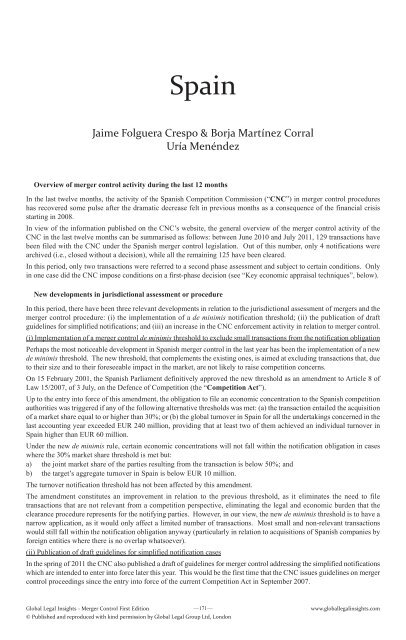Merger Controls First Edition - J Sagar Associates
Merger Controls First Edition - J Sagar Associates
Merger Controls First Edition - J Sagar Associates
You also want an ePaper? Increase the reach of your titles
YUMPU automatically turns print PDFs into web optimized ePapers that Google loves.
Spain<br />
Jaime Folguera Crespo & Borja Martínez Corral<br />
Uría Menéndez<br />
Overview of merger control activity during the last 12 months<br />
In the last twelve months, the activity of the Spanish Competition Commission (“CNC”) in merger control procedures<br />
has recovered some pulse after the dramatic decrease felt in previous months as a consequence of the financial crisis<br />
starting in 2008.<br />
In view of the information published on the CNC’s website, the general overview of the merger control activity of the<br />
CNC in the last twelve months can be summarised as follows: between June 2010 and July 2011, 129 transactions have<br />
been filed with the CNC under the Spanish merger control legislation. Out of this number, only 4 notifications were<br />
archived (i.e., closed without a decision), while all the remaining 125 have been cleared.<br />
In this period, only two transactions were referred to a second phase assessment and subject to certain conditions. Only<br />
in one case did the CNC impose conditions on a first-phase decision (see “Key economic appraisal techniques”, below).<br />
New developments in jurisdictional assessment or procedure<br />
In this period, there have been three relevant developments in relation to the jurisdictional assessment of mergers and the<br />
merger control procedure: (i) the implementation of a de minimis notification threshold; (ii) the publication of draft<br />
guidelines for simplified notifications; and (iii) an increase in the CNC enforcement activity in relation to merger control.<br />
(i) Implementation of a merger control de minimis threshold to exclude small transactions from the notification obligation<br />
Perhaps the most noticeable development in Spanish merger control in the last year has been the implementation of a new<br />
de minimis threshold. The new threshold, that complements the existing ones, is aimed at excluding transactions that, due<br />
to their size and to their foreseeable impact in the market, are not likely to raise competition concerns.<br />
On 15 February 2001, the Spanish Parliament definitively approved the new threshold as an amendment to Article 8 of<br />
Law 15/2007, of 3 July, on the Defence of Competition (the “Competition Act”).<br />
Up to the entry into force of this amendment, the obligation to file an economic concentration to the Spanish competition<br />
authorities was triggered if any of the following alternative thresholds was met: (a) the transaction entailed the acquisition<br />
of a market share equal to or higher than 30%; or (b) the global turnover in Spain for all the undertakings concerned in the<br />
last accounting year exceeded EUR 240 million, providing that at least two of them achieved an individual turnover in<br />
Spain higher than EUR 60 million.<br />
Under the new de minimis rule, certain economic concentrations will not fall within the notification obligation in cases<br />
where the 30% market share threshold is met but:<br />
a) the joint market share of the parties resulting from the transaction is below 50%; and<br />
b) the target’s aggregate turnover in Spain is below EUR 10 million.<br />
The turnover notification threshold has not been affected by this amendment.<br />
The amendment constitutes an improvement in relation to the previous threshold, as it eliminates the need to file<br />
transactions that are not relevant from a competition perspective, eliminating the legal and economic burden that the<br />
clearance procedure represents for the notifying parties. However, in our view, the new de minimis threshold is to have a<br />
narrow application, as it would only affect a limited number of transactions. Most small and non-relevant transactions<br />
would still fall within the notification obligation anyway (particularly in relation to acquisitions of Spanish companies by<br />
foreign entities where there is no overlap whatsoever).<br />
(ii) Publication of draft guidelines for simplified notification cases<br />
In the spring of 2011 the CNC also published a draft of guidelines for merger control addressing the simplified notifications<br />
which are intended to enter into force later this year. This would be the first time that the CNC issues guidelines on merger<br />
control proceedings since the entry into force of the current Competition Act in September 2007.<br />
Global Legal Insights <strong>Merger</strong> Control <strong>First</strong> <strong>Edition</strong><br />
—171—<br />
© Published and reproduced with kind permission by Global Legal Group Ltd, London<br />
www.globallegalinsights.com


